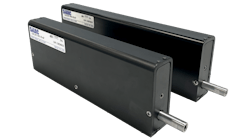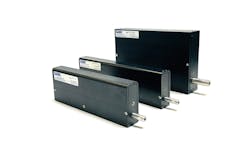Pneumatic actuators – also referred to as air cylinders – continue to play in important role in many applications. However, electric alternatives are gaining ground due to the many performance benefits they can provide. These include a longer cycle life and programmability.
Low cost and fast actuation speeds have been among the advantages offered by pneumatic actuators. Ed Neff, CEO of SMAC Corp., says a typical pneumatic system comprised of a 25 mm stroke crimped type air cylinder with position switches, solenoid valve, flow controls, etc. costs around $200-250 in low volumes. This is about 50% less than the lowest cost electronic competition he says.
Regarding speed, Neff says pneumatic actuators operate at faster speeds than the most commonly available electric actuators – ball screw types. This typically equates to 800 cycles per minute for a 25 mm stroke. Their force to package size ratio is also better than electric which he says is important in clamping applications or when moving large objects.
But for those applications where performance is more important than cost, electric actuators may be the better option. Advancements in the technology and how it is manufactured are also helping it to become a comparably priced alternative to pneumatic actuators.
Advantages of Going Electric
Cycle life is one of the areas in which electric actuators can provide an advantage over pneumatic. According to Neff, pneumatic actuators have a short life of about 10 million cycles in slow moving applications and 1 million for high cycle rate applications. Ball screw electric actuators have a similar cycle life.
However, linear motor based electric actuators which have become more prevalent over the past decade or so have a cycle life which is 10 times greater than both pneumatic and ball screw actuators says Neff. Cycle rates are also two times higher.
For applications in which rotation of the pneumatic actuator’s rod is unwanted, electric could be the better option. If using pneumatics, the solution would be to have a double rod to prevent this rotation but that increases the component’s cost to a price similar to that of a conventional electric actuator.
Programmability is another key advantage electric actuators offer. Manual setup and adjustment is required for pneumatic actuators, and it is difficult to get precise feedback on their speed and position. Whereas an encoder is embedded into an electric actuator allowing for more precise movement. And with the increased use of computers in industrial environments and need for precision in many applications, the ability to program an actuator can greatly benefit an end-use customer.
Power sources are another area in which electric actuators can be advantageous. Electricity—which is already needed for other aspects of a facility—can be used to power electric actuators. But pneumatic actuators require the installation of air compressors which can take up space in a facility and add cost. They can also be noisy, and many regions such as Europe have begun to regulate the noise within facilities to help improve the health of workers. Electric actuators, on the other hand, operate quietly.
Watch SMAC's video demonstrating the benefits of electric actuators over pneumatic.
Linear Motor Actuators
In some applications, the advantages provided by using certain types of electric actuators outweigh the lower cost benefit provided by pneumatic versions. Neff says these include applications in which high speed and long cycle life is desired.
Linear motor electric actuators like the type developed by SMAC are beneficial in these types of applications he says. SMAC’s actuators use moving coil actuator technology in which the coil is used to generate the force necessary to move the actuator, and it is mounted on a linear guide.
Testing of the cylinders has shown a life cycle over 100 million and Neff says the only part that wears is the linear guide. Pneumatic options have a shorter life cycle and often experience failure due to the wear put on components such as the piston seal. Electronic components typically have fewer moving parts which helps to reduce the amount of wear—and therefore maintenance or failure experienced by other components.
Neff says linear motor electric actuators are also 50% faster than their pneumatic counterparts. “Linear motors are very fast. All we are moving is the coil which weighs almost nothing,” he explains.
Again, the ability to program the speed and position of the electric actuator and not having to make any manual adjustments is a benefit over pneumatic options. Some electric actuators also allow force to be programmed, further benefiting end-use customers.
Because the linear motor electric actuators are mounted on a linear guide there are no rotating shafts, offering an advantage for use in applications where rotation of the shaft is not wanted.
Overcoming Cost Challenges
Cost remains the number one hurdle to electric actuators overtaking pneumatic actuators in the marketplace. While there are many advantages electric can offer, the fact they are often three times the price of pneumatic actuators can be a difficult proposition.
Overcoming that cost hurdle is where the industry needs to focus. Neff says that is what SMAC has been working on for the past 20 years.
Reducing manufacturing costs of electric actuators was the first step. The company was able to achieve this by using advanced manufacturing methods including:
- laser cut parts,
- printed coils instead of wound coils,
- encoders designed into the printed coils that cost less than $15, and
- very low-cost controller amplifiers that are based on drone controllers.
Use of a high wattage laser cutting machine allows the company to product about 400 parts per hour, a comparable production speed to that of the machines typically used to produce pneumatic components. “That brings the manufactured cost of mechanical costs [to the same price],” says Neff.
The company has benefitted from the declining costs of encoders and controllers as well. When it first started to develop electric actuators the cost of an encoder was around $125. Now it is under $15 because the company makes its own encoders.
SMAC’s Derry, NH-based division SMAC-EMC has developed, tested and manufactured its own line of optical encoders. This has helped not only to bring production costs for actuators down but also aided with supply chain issues that many companies are facing. This eliminates dependence upon a supplier and enables the company to control the cost.
Controllers used for the actuators are under $25 says Neff because the company has sourced controller chips used in drones. Because they are a high-volume consumer electronics component they are inexpensive while still providing the precision needed for the movement of the actuator.
Printing the coils used in its actuators instead of winding them like other manufacturers do has also helped to reduce manufacturing costs. Neff equates it to circuit board manufacturing technology – they can be printed anywhere and as many as 5,000 per day can be printed on a standard commercial machine. This reduces machine tooling and parts cost without compromising quality which is actually improved. Neff says coil resistance variation is reduced by 90% because it is printed instead of wound.
These reductions in manufacturing costs bring the price of the electric actuators in line with those of non-rotating pneumatic versions, providing an avenue for their use in applications where high speed or precision assembly is required.
Watch SMAC's video showing the benefits of using electric actuators for product labeling.
Neff says there is still an upfront cost advantage for pneumatic actuators as well as their favorable size to force ratio. And for applications requiring higher forces, pneumatics will still have the advantage. But as costs continue to decline for electric actuators, particularly as volumes increase, within about 10 years it could be possible the price for electric matches that of pneumatic solutions.
He concludes that pneumatics could parallel hydraulics in regards to electric solutions becoming more prevalent in the market, but says a drop in their use will be slower as there will likely always be a use case in which pneumatic actuators are the preferred choice.



